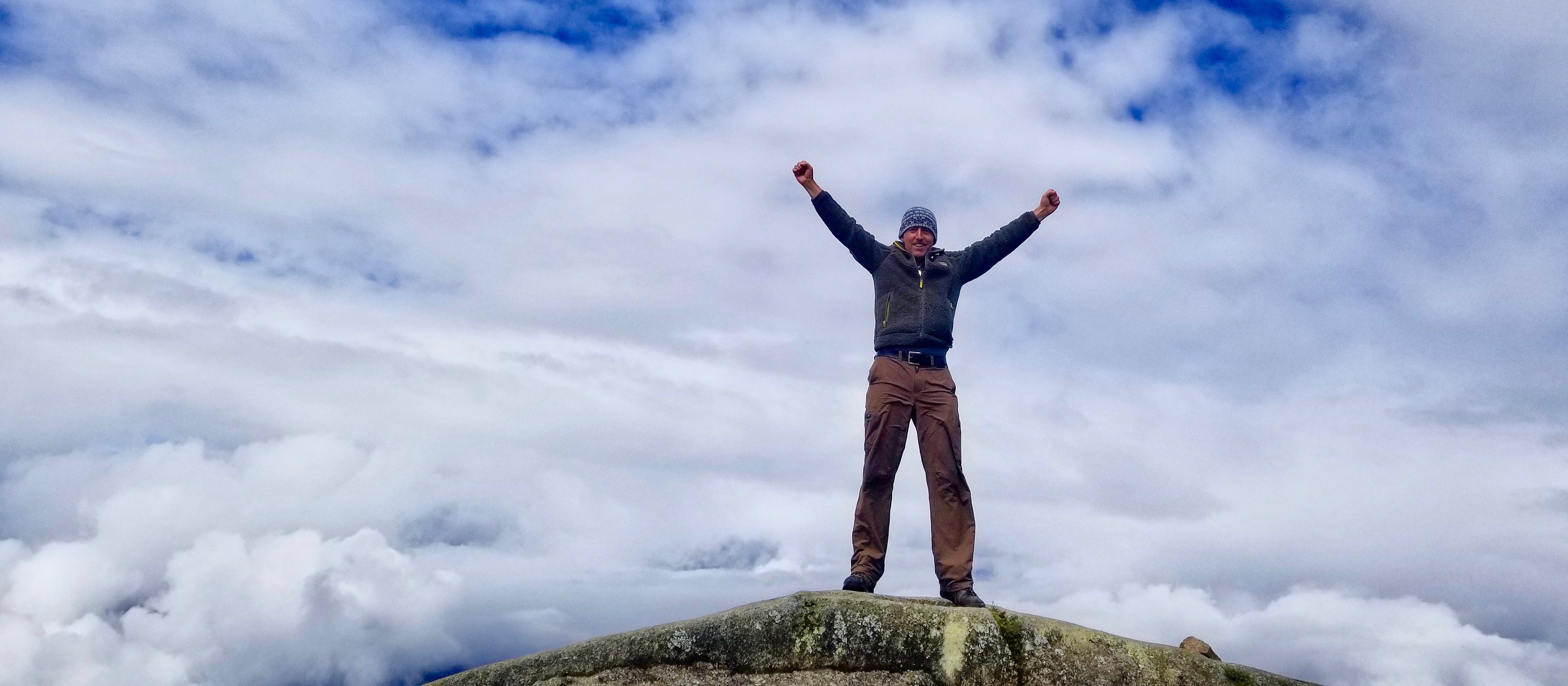Pushing Limits Beyond the Comfort Zone
August 14th 2015 is a date I will never forget. After climbing Machu Picchu Mountain, I proposed to my now wife Yesi at the lost city of the Inca’s. But earlier, at the top of the mountain, I became stuck on a narrow stone ledge, while Yesi climbed up a near vertical stairway to the summit. Fear prevented me from going further. That day, as I huddled against the rock face waiting for Yesi to come back down from the summit, I stared out over Machu Picchu, to the high snowy peaks of the Urubamba Mountains beyond. There was so much to see and explore. Yet I thought I could never overcome my fear of heights.
Three years later, by pushing limits and going beyond my comfort zone, I scaled those very peaks by hiking the 4-day Classic Inca Trail. By doing so, I learned that obstacles can be overcome, and goals, no matter how far away they seem, can be reached.

I was stuck on a ledge on Machu Picchu mountain, unable to get to the summit.

The snowy peaks of the Urubamba Mountains reaching for the clouds. They represented a non-achievable goal in 2015.
The fear that gripped me on that narrow ledge on Machu Picchu Mountain was rooted in a lack of self-confidence and awareness; the result of a life spent looking down not up. The fear was born out of negativity. Pushing limits at that time was not on my agenda. I was in a comfort zone, telling myself I was not capable of going beyond.
Pushing Limits on the Inca Trail
But on December 14th 2018, I scaled ‘Dead Woman’s Pass‘ on the Inca Trail. In doing so, I got to 14.000 feet – over six thousand feet above that ledge where I had been stuck. It was an absolutely unforgettable experience to be so high above the clouds, and so far above the point where I previously felt so much fear.

High above the clouds, at 14,000 feet on the Inca Trail

Seeing beauty which I previously thought I would not get to see
Seeing such beauty, and knowing that I had challenged my fears and worked hard to get there was a magical moment. The only thing that has changed since being stuck on that ledge is my attitude. In 2015, I was looking down, to where I had come from. Now, my natural inclination is to look up. The things that have made all the difference are meditation, and the use of mindfulness to stay in the present moment, where fear cannot penetrate.
Meditation allows me (or anyone else) to set about pushing limits by muting the many negative thoughts which give rise to self doubt and fear. Our natural state of being is not based on negativity and fear. We place these obstacles in front of ourselves due to a lack of awareness. Meditation allows us to see that we have an innate ability (hence my business name In8 Motivation) to achieve great things.
Pushing Limits With Mindfulness
When we learn to use mindfulness to stay in the present moment, we see the world in a completely different way. It’s the same world, the same mountain, the same ledge, the same drop; but we see it through different eyes. This applies to adventures, our careers, relationships, health and so much more. This forms the basis of the Mindfulness and Motivation workshops I deliver in New York City.
Fear lives in the past and the future. When we position ourselves in the present, we can naturally measure our ability, and see that we can achieve much more than our negative self would allow us to believe. Dead woman’s pass is not Everest, but it is 6,000 feet above the point where I sat crippled by fear just three years earlier. That is tangible progress. I’m proud of what I achieved on the Inca Trail, with its high passes, steep rugged steps and many narrow ledges. But I am especially happy to discover once again that meditation is the fuel for motivation to grow as a person and achieve goals. Pushing limits allows us to see the world in a different way. Fear loses it’s potency when challenged by a fully motivated, fully positive mindset.
Pushing Limits With Shared Positivity
Over 4 years ago I embarked on a process of self improvement through meditation and positive thinking. I am inspired by many things and many people. In 2016, after I cycled on Trans-Atlantic Cycle across America, Liam Porter penned a motivational poem inspired by myself and Jason Black called Life Cycle.

‘Life Cycle’ – An inspirational poem by Liam Porter
The funny thing is, that poem, which I have stuck to the refrigerator in our apartment in New York, inspires me every day. Liam followed it up in 2018 with another poem called Magic, which speaks of goal setting, pushing limits and the rewards that come with being proactively engaged in personal development. There is an important message revealed in those poems. Positivity towards goal setting and pushing limits is a phenomenal force when shared. Liam said I inspired him, yet he also inspires me. That is the power of shared positivity. Try it!

‘Magic’ – A poem about motivation and perseverance towards achieving goals, by Liam Porter
Pushing Limits And A More Fulfilling Life
Dwelling in negativity and accepting less than what we are capable of is a toxic quagmire. By pushing limits in terms of our thinking and our willingness to share positivity, we can not only feel better about ourselves and others, but we can achieve so many great things. Shared positivity, meditation and pushing limits can propel us towards new levels, where life becomes so much more fulfilling. I am going to keep looking up with a positive mindful attitude – who knows what will come next. Well, I already know, but Im not telling you yet!



























